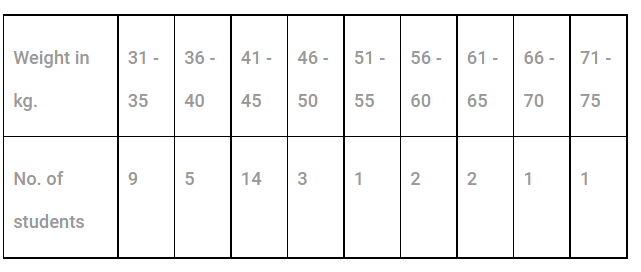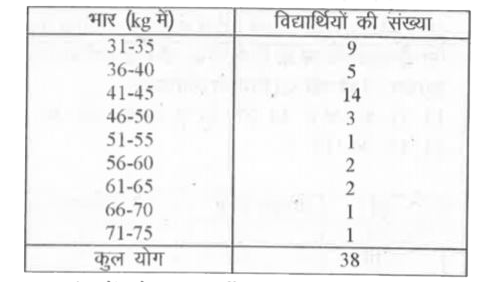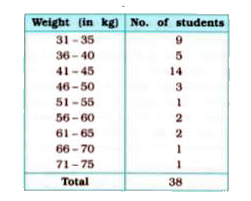Consider the frequency distribution table (Table 14.3, Example 4, Chapter 14), which gives the weights of 38 students of a class. (i) Find the probability that the weight of a student in the class lies in the interval 46-50 kg. (ii) Give two events in this context, one having probability 0 and the other having probability 1.Solution in Punjabi
Step by step video & image solution for Consider the frequency distribution table (Table 14.3, Example 4, Chapter 14), which gives the weights of 38 students of a class. (i) Find the probability that the weight of a student in the class lies in the interval 46-50 kg. (ii) Give two events in this context, one having probability 0 and the other having probability 1. by Maths experts to help you in doubts & scoring excellent marks in Class 9 exams.
Updated on:21/07/2023Topper's Solved these Questions
Similar Questions
A coin is tossed 1000 times with the following frequencies: Head : 455, Tail : 545 Compute the probability for each event.
View SolutionFind the degree of the polynomials given below: x5−x4+3
View SolutionState whether the following statement is always true, always false or ambiguous. Justify your answers. There are 8 days in a week.
View SolutionLet us now consider the following frequency distribution table which gives the weights of 38 students of a class:
View SolutionConsider the frequency distribution table (Table 14.3, Example 4, Chapter 14), which gives the weights of 38 students of a class. (i) Find the probability that the weight of a student in the class lies in the interval 46-50 kg.(ii) Give two events in this context, one having probability 0 and the other having probability 1.
View SolutionFollowing frequency distribution given the weights of 38 students of a class:

Find the probability that weight of a student in the class is:
View SolutionFollowing frequency distribution gives the weights of 40 students of a class .

A student from the class is chosen at random . What is the probability that the weight of the chosen student is
(i) at most 60 kg (ii) at least 56 kg (iii) not more than 50 kg ?
View Solutionनिम्नलिखित सारणी में एक कक्षा के विद्यार्थियों के 38 भार दिए गए है।
(i) इस बात की प्रायिकता ज्ञात कीजिए जिसमे कक्षा के एक विद्यार्थी का भार (kg में) अंतराल 46-50 में स्थित हो।
(ii) इस संदर्भ में ऐसी दो घटनाएँ बताइए जिनमे एक की प्रायिकता 0 हो और दूसरी की प्रायिकता 1 हो।

View Solutionएक कक्षा के 38 विद्यार्थियों के भारों को निम्नलिखित बारंबारता बंटन में दर्शाया गया है

प्रायिकता ज्ञात कीजिए कि कक्षा में विद्यार्थियों के भार है। (i) अधिक से अधिक 60 किग्रा (ii) कम-से-कम 36 kg (iii) 50 किग्रा से अधिक नहीं। इस बंटन में दो घटनाओं को भी परिभाषित कीजिए जिनमें एक की प्रायिकता 0 तथा अन्य की प्रायिकता 1 है।
View Solutionनिम्नलिखित बारम्बारता बंटन सारणी पर विचार कीजिए, जिसमें एक कक्षा के 38 विद्यार्थियों के भार दिए गए है:

इन आंकड़ों को सतत वर्गीकृत बारम्बारता सारणी के रूप में प्रस्तुत कीजिए। साथ ही 35.5 kg भार और 40.5 kg भार वाले विद्यार्थियों को भी उपयुक्त सारणी में सम्मिलित कीजिए।
View Solutionकिसी कक्षा के 48 विद्यार्थियों का भार (kg) नीचे दिया गया है।

(i) उस विद्यार्थी के भार की प्रायिकता ज्ञात करें जो वर्ग अंतराल (46-50) kg में है।
(ii) दो ऐसी घटनाओं की प्रायिकता ज्ञात करें जिसमें एक की प्रायिकता शून्य है एवं दूसरे की एक|
View SolutionConsider the frequency distribution table (Table 14.3, Example 4, Chapter 14), which gives the weights of 38 students of a class. (i) Find the probability that the weight of a student in the class lies in the interval 46-50 kg.(ii) Give two events in this context, one having probability 0 and the other having probability 1.
View SolutionFollowing frequency distribution given the weights of 38 students of a class: Weight in Kg: 31-35 36-40, 41-45, 46-50, 51-55, 56-60 61-65, 66-70 71-75 No. of students 9 5 14 3 1 2 2 1 1 Find the probability that weight of a student in the class is: (i)at most 60 kg (ii)at least 36 kg (iii)not more than 50kg. Also define two events in this context, one having probability 0 and the other having probability 1.
View SolutionLet us now consider the following frequency distribution table which gives the weights of 38 students of a class :

Convert the classes of above frequency distribution to continuous classes to include two new students weighing 35.5 kg and 40.5 kg.
View SolutionThe distribution below gives the weights of 30 students of a class. Find the median weight of the students :
Weight (in kg) 40−4545−5050−5555−6060−6565−7070−75Number of students 2 3 8 6 6 3 2
View Solution
